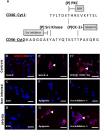Induction of Proinflammatory Multiple Sclerosis-Associated Retrovirus Envelope Protein by Human Herpesvirus-6A and CD46 Receptor Engagement
- PMID: 30574140
- PMCID: PMC6291489
- DOI: 10.3389/fimmu.2018.02803
Induction of Proinflammatory Multiple Sclerosis-Associated Retrovirus Envelope Protein by Human Herpesvirus-6A and CD46 Receptor Engagement
Abstract
The aberrant expression of human endogenous retrovirus (HERV) elements of the HERV-W family has been associated with different diseases, including multiple sclerosis (MS). In particular, the expression of the envelope protein (Env) from the multiple sclerosis-associated retrovirus (MSRV), a member of HERV-W family and known for its potent proinflammatory activity, is repeatedly detected in the brain lesions and blood of MS patients. Furthermore, human herpesvirus 6 (HHV-6) infection has long been suspected to play a role in the pathogenesis of MS and neuroinflammation. We show here that both HHV-6A and stimulation of its receptor, transmembrane glycoprotein CD46, induce the expression of MSRV-Env. The engagement of extracellular domains SCR3 and SCR4 of CD46-Cyt1 isoform was required for MSRV-env transactivation, limiting thus the MSRV-Env induction to the CD46 ligands binding these domains, including C3b component of complement, specific monoclonal antibodies, and both infectious and UV-inactivated HHV-6A, but neither HHV-6B nor measles virus vaccine strain. Induction of MSRV-Env required CD46 Cyt-1 singling and was abolished by the inhibitors of protein kinase C. Finally, both membrane-expressed and secreted MSRV-Env trigger TLR4 signaling, displaying thus a proinflammatory potential, characteristic for this viral protein. These data expand the specter of HHV-6A effects in the modulation of the immune response and support the hypothesis that cross-talks between exogenous and endogenous viruses may contribute to inflammatory diseases and participate in neuroinflammation. Furthermore, they reveal a new function of CD46, known as an inhibitor of complement activation and receptor for several pathogens, in transactivation of HERV env genes, which may play an important role in the pathogenesis of inflammatory diseases.
Keywords: CD46; HHV-6A; MSRV; TLR4; human endogenous retrovirus; inflammation; multiple sclerosis.
Figures








Similar articles
-
Brains and peripheral blood mononuclear cells of multiple sclerosis (MS) patients hyperexpress MS-associated retrovirus/HERV-W endogenous retrovirus, but not Human herpesvirus 6.J Gen Virol. 2007 Jan;88(Pt 1):264-274. doi: 10.1099/vir.0.81890-0. J Gen Virol. 2007. PMID: 17170460
-
Anti-Human Herpesvirus 6 A/B Antibodies Titers Correlate With Multiple Sclerosis-Associated Retrovirus Envelope Expression.Front Immunol. 2021 Nov 29;12:798003. doi: 10.3389/fimmu.2021.798003. eCollection 2021. Front Immunol. 2021. PMID: 34912348 Free PMC article.
-
Preclinical and early clinical development of GNbAC1, a humanized IgG4 monoclonal antibody targeting endogenous retroviral MSRV-Env protein.MAbs. 2015;7(1):265-75. doi: 10.4161/19420862.2014.985021. MAbs. 2015. PMID: 25427053 Free PMC article. Clinical Trial.
-
The aliens inside us: HERV-W endogenous retroviruses and multiple sclerosis.Mult Scler. 2018 Jan;24(1):42-47. doi: 10.1177/1352458517737370. Mult Scler. 2018. PMID: 29307292 Review.
-
The human endogenous retrovirus link between genes and environment in multiple sclerosis and in multifactorial diseases associating neuroinflammation.Clin Rev Allergy Immunol. 2010 Aug;39(1):51-61. doi: 10.1007/s12016-009-8170-x. Clin Rev Allergy Immunol. 2010. PMID: 19697163 Review.
Cited by
-
Neural Cell Responses Upon Exposure to Human Endogenous Retroviruses.Front Genet. 2019 Jul 11;10:655. doi: 10.3389/fgene.2019.00655. eCollection 2019. Front Genet. 2019. PMID: 31354794 Free PMC article. Review.
-
HERV-W ENV Induces Innate Immune Activation and Neuronal Apoptosis via linc01930/cGAS Axis in Recent-Onset Schizophrenia.Int J Mol Sci. 2023 Feb 3;24(3):3000. doi: 10.3390/ijms24033000. Int J Mol Sci. 2023. PMID: 36769337 Free PMC article.
-
Activation of Endogenous Retrovirus, Brain Infections and Environmental Insults in Neurodegeneration and Alzheimer's Disease.Int J Mol Sci. 2021 Jul 6;22(14):7263. doi: 10.3390/ijms22147263. Int J Mol Sci. 2021. PMID: 34298881 Free PMC article. Review.
-
The Relationship of the Mechanisms of the Pathogenesis of Multiple Sclerosis and the Expression of Endogenous Retroviruses.Biology (Basel). 2020 Dec 11;9(12):464. doi: 10.3390/biology9120464. Biology (Basel). 2020. PMID: 33322628 Free PMC article. Review.
-
The relationship between HERVs and exogenous viral infections: A focus on the value of HERVs in disease prediction and treatment.Virulence. 2025 Dec;16(1):2523888. doi: 10.1080/21505594.2025.2523888. Epub 2025 Jul 1. Virulence. 2025. PMID: 40590391 Free PMC article. Review.
References
Publication types
MeSH terms
Substances
LinkOut - more resources
Full Text Sources
Medical
Molecular Biology Databases

